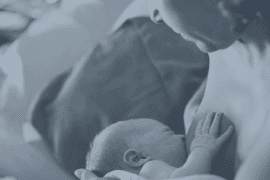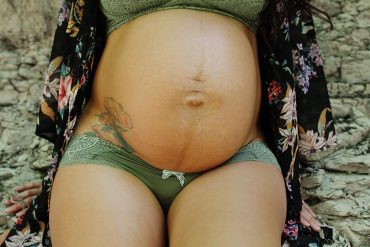We want the baby to come to the breast CHIN FIRST. The chin is the first thing that makes contact with the breast. We want the baby really close to you. If clothes are bunched up in the way, or baby’s hands are at their chin, they will get less breast in their mouth. And we want their mouth full of breast. If they come to the breast chin first, with the nipple under their nose, they are more likely to tilt back and get a good mouthful.
If I offered you a drink of water now, you’d naturally raise your chin away from your chest to swallow. Try and swallow with your chin pointing down – it’s hard. And it’s also hard to swallow if your neck is twisted. We want a baby’s ear, shoulder and hip to all be pointing in the same direction. Babies don’t like it if they don’t feel anchored and secure and they don’t like it if someone is pushing on the back of their head and holding their head tightly. They want freedom to be able to tilt their head back, so we support their bodies and around their shoulders. Often leaning back helps make breastfeeding more comfortable. Have a look at some of the resources online about biological nurturing or laid-back breastfeeding.
Remind yourself about what an effective latch looks like by watching this video.
Sometimes a few days go past, or weeks, and things change without us even noticing. If breastfeeding has become more uncomfortable, it might be that a baby has got a little heavier and the position you used when baby was tiny now means their weight is pulling them off the breast.
4. Know how to measure how much milk is going in
It’s true that most new babies are going to be weighed a little less over the coming weeks. Again, if you are really worried, there are people who may be able to support you with this, but we’re not going to be popping to the weighing clinic as we once did.
Some families are hiring or buying baby scales to use at home. Sometimes this is valuable, but over-weighing is not always useful and can make you feel more anxious. Talk to someone about how often is sensible for your situation.
It’s not a great plan to rely on using normal bathroom scales and trying to weigh yourself and then weigh yourself holding baby. This will often have accuracy problems and we are usually only talking about 100 grams here and there.
Nappies are the key. When a baby is one day old, we’ll see one poo and one pee in 24 hours. On day 2, two poos and two pees. From then on, we’ll see AT LEAST two poos every 24 hours (the size of a £2 coin or bigger). More poo is better and babies taking in lots of milk will do often more than 4. The poo will change in colour. The first day we will see black sticky tarry poo called meconium. As the days go by, the poo gets paler. By day 2-3, often a bit greenish. We don’t want to see black poo any more after day 4, and talk to someone if you do. By day 4-5, we should be seeing pale, mustardy poo. We carry on seeing several poos a day for the next few weeks. Only around 6 weeks does it slow down for some exclusively breastfed babies and their poo rate may start to slow down and they may skip some days. But young babies do not skip days. We need several poos a day to know milk is going in as it should.
With pee, we want 3 pees on day 3. Four pees on day 4. On day 5, five wet nappies. From then on, 6 or more heavy wet nappies in 24 hours. You shouldn’t have to think, “Hmmm, was there a pee?”, the nappy should feel heavy enough that you know. If you aren’t sure, talk to someone.
Click here for more info.
5. Know how to see milk going in
It’s not only nappies that can tell us a baby is getting milk. We can look at the top end too. I don’t mean a baby is being sick (although that sometimes happens, and if nappies are good and the baby doesn’t seem to mind, and it’s not projectile, that can be OK.)
I’m talking about knowing what a baby swallowing milk looks like.
Breastfeeding happens for lots of different reasons. Sometimes babies are there to feel safe, to help them fall asleep, to feel comforted. All that is important and to be valued.
Babies are supposed to ‘use us like a dummy’. They have a lot of brain development to do and they are learning important things about trust and comfort. But we don’t want them to only be on the breast to suckle and comfort themselves. It’s good to be able to recognise when milk is definitely going in.
At the start of a feed, a baby will suckle quickly to get the milk flowing. Then they will settle into a suck/swallow pattern where you will be able to hear them swallowing milk. In the first few days, when your milk is still the rich colostrum, you may hear less gulping. But when the milk has begun to transition around day 2-4 and it’s changing to mature milk which is lower in protein, higher in fat and higher in volume, you’ll hear some swallowing at the start of a feed. As the milk gradually gets fattier (which happens gradually as the minutes go by), you may notice they do more sucks for every swallow. But they will still be swallowing. How do you tell when a baby is swallowing?
Have a look at another video from Global Health Media.
And this video from Dr Jack Newman.
We’re looking for the chin to come down and a pause in the chin to indicate a swallow. By the way, you can’t always tell how much milk a baby is getting by counting how many minutes they are on the breast. A feed that lasts 30 minutes isn’t necessarily ‘better’ than one that lasts 8 minutes. It’s all about what they are DOING in those minutes.
This breastfeeding assessment tool from UNICEF Baby Friendly explains that an effective breastfeed may be anything from 5 to 40 minutes. There are lots of good ideas about how to check feeding is going well.










